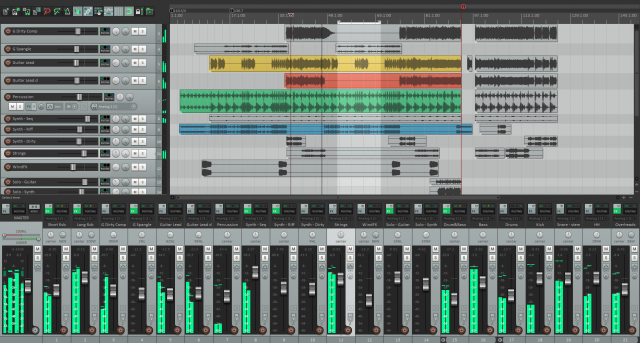Reaper 5 is out today. It’s the compact, tight, powerful music and audio production software whose users would like to know why more of you aren’t talking about it.
And they have a point. Reaper 5 is US$60 with a bunch of included free upgrades, or a voluntary $225 for “commercial” use. Even the demo runs a full 60 days with no restrictions. Yet Reaper does a lot of things other DAWs don’t – even some of the priciest out there – in a compact tool that has exhaustive hardware and OS support, plus complete scripting.
Now, what Reaper 5 doesn’t have is some easy way of describing in marketing terms. There’s actually not a single sort of “banner” feature. It’d be easier to say that Reaper 5 does what the earlier versions of Reaper does, but “more better.” And so knowing how passionate Reaper users are, I’d love to hear what you care about most.
Also, the simple answer to why more people don’t talk about Reaper is simple. Reaper users love it because the software does stuff other people don’t necessarily care enough about. Unfortunately, some of those people don’t care enough about it to … uh, use Reaper.
But don’t let the nerdiness turn you off. This is a great DAW at a kind of insanely-low, don’t tell your accountants price.
And I can sum up what I think are version 5’s most significant overall improvements:
1. It’ll make you happy if you use video. Support for adding videos to projects is a big feature of Reaper, and now it’s massively improved, including powerful features for decoding and displaying video with high resolution, high performance playback.
2. It has an entire script development environment, built in. Okay, this is pretty geeky, but developers get richer-than-ever options for Lua scripting right in the DAW – including their own IDE. If you don’t code, the upshot is, the people who do can do it more quickly and reliably – and then you can use their scripts to save time. There are tons of API additions, too.
3. It handles multichannel media really well. This lets you edit more easily with formats like Ambisonics.
4. It’s insanely powerful at automation. Automation is recorded per take, and now includes various performance enhancements. It’s sample-accurate with VST3 and JSFX. (We have black MIDI; maybe black VST can be a thing?) All of this can be managed from the Project Bay, too.
5. It’ll keep time however you like. Custom metronome beat patterns ticks away as you want, and a ruler can now accurately display time signature, tempo, and highly accurate video frame info.
6. It’s got a prettier theme. More theme customization options, too.
7. You can group controls. Link track controls wherever you want in the signal flow.
8. It adds MIDI control. MIDI note off velocity is editable, and there are new options for more precisely editing node edges with the mouse.
9. It’s faster and more efficient. There are performance improvements everywhere. I could go into them, but they’re boring to write about, so instead I’ll do what they do and save you time.
10. It doesn’t abandon older OSes. Okay, that’s not an upgrade – but it’s the absence of a downgrade. And in an industry where this is increasingly uncommon, you can run Reaper all the way back to XP on Windows, or 10.5 on OS X. (Note that the same can’t be said of all the plug-in formats and plug-ins, but still.) It also plays nice under WINE, so you can run it under Linux even though there’s not a Linux native version.
Video support (for film/TV scoring, for instance) is a major difference between Reaper and PreSonus’ Studio One, as mentioned before. So, too, is scriptability. So while I do admire Studio One, those could be deciding points from some readers, as we heard in comments.
And Reaper still does the stuff it already did well. That includes loads of multichannel and routing features (including real surround support), lots of nice built-in effects, modulation features, and OSC support for easy control. And it’s small enough to put on a portable drive, so you can take it with you to someone else’s studio.
But you don’t have to take my word for it. You can try it for two months free and see if it makes you happy.
And for more, turn to the founder of developer Cockos.
Justin Frankel isn’t just an important name in the world of DAWs. He has possibly the most unique resume in the business, as the man behind Winamp and gnutella (kids, ask your Gen X parents about that file sharing service), not to mention making a crucifix-shaped programmable DSP platform called Jesusonic.
Seriously, the number of people who have both sold a company to AOL and made a big messiah-themed effects platform are … one.
He spoke to our friends at SonicScoop, wearing a possibly Jesus-ish beard.
And talks about what makes the tool special:
And has
And for more:
Meanwhile, the roots of that Jesusonic remain in Reaper. I just hope for Reaper hardware. Because:
http://www.cockos.com/jesusonic/
And if you do want to learn scripting:

